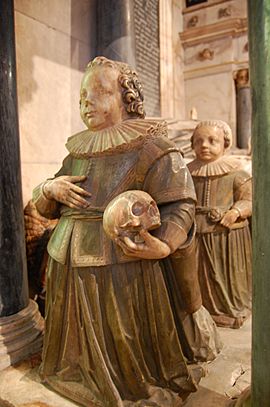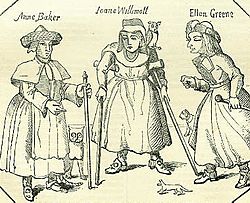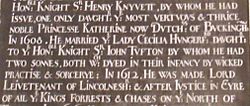Witches of Belvoir facts for kids

The Witches of Belvoir were a mother and her two daughters who were accused of witchcraft in England. They were blamed for the deaths of two young brothers, Henry (who died in 1613) and Francis Manners (who died in 1620). These boys were the heirs to Francis Manners, 6th Earl of Rutland, whose home was Belvoir Castle. The mother, Joan Flower, died on her way to her trial. Her two daughters, Margaret and Philippa, were planned to be hanged in Lincoln.
Contents
The Flower Family at Belvoir Castle
Joan, Margaret, and Philippa Flower were known for being "herbal healers." They came from a local family that was having a tough time financially. They got jobs as servants for the 6th Earl and Countess of Rutland at Belvoir Castle, which is near Grantham, Lincolnshire. They were hired because extra staff were needed for an upcoming visit by King James I.
However, the Flower sisters and their mother were not popular with the other servants. There were talks of them stealing things and causing trouble. Because of this, all three were fired. Only Joan received some money and items as a payment for leaving.
Illnesses and Deaths of the Rutland Children
After the Flowers were fired, the Earl and Countess became very sick. They suffered from "vomiting and convulsions." Their oldest son and heir, Henry, Baron de Ros, died and was buried on September 26, 1613. Their younger children, Francis and their daughter Katherine, also became ill in a similar way. Francis died on March 7, 1620.
The deaths of the two boys meant the Earl had no male heir. This was a big problem because it meant his family line would not continue the Earldom. After the Earl himself died in 1632, the title passed to his brother.
Accusations of Witchcraft
Three years after Henry's death, in 1616, nine women were hanged in Leicestershire. They were accused of bewitching a young boy. These accusations were similar to what the Flowers would face, including claims that they kept cats as "familiars" (spirit helpers).
It was five years after the Flowers were fired from Belvoir Castle, and after their second son Francis died, that the Rutlands had them arrested. This happened before Christmas in 1618. After some initial questioning in February 1619, the women were to be taken to Lincoln prison.
Joan Flower's Death
When she was arrested, Joan Flower said she was innocent. She wasn't known for going to church. But on the way to the prison in Lincoln, in a town called Ancaster, she asked for bread. She wanted it as a substitute for the Eucharist (a holy bread used in church). She claimed that a witch could not eat something so blessed. Sadly, she choked and died after her first bite.
Confessions of the Sisters
At Lincoln, Margaret accused her mother of witchcraft. Philippa admitted to witchcraft for herself, Margaret, and Joan. The sisters said they had made deals with familiar spirits. These spirits supposedly helped them with their evil plans. Their mother's familiar was a cat named Rutterkin.
The women admitted they stole a glove belonging to Lord Ros (Henry). They said they gave it to their mother, who dipped it in boiling water, rubbed it along Rutterkin's back, and pricked it. They claimed that along with some magic words, this caused Lord Ros to get sick and die. They also tried to harm Lady Katherine, the Earl's daughter. But they said Rutterkin had no power over her, so it failed.
The women also took some feathers from Rutland's bed quilt and a pair of gloves. They boiled these in water mixed with blood. They claimed these spells were meant to stop the Earl and Countess from having any more children. Both sisters said they saw visions of devils. They also claimed their familiar spirits visited them and "sucked" at their bodies.
Other Accused Women
During their questioning, the sisters named other women who had helped them. These were Anne Baker from Bottesford, Joan Willimot from Goadby, and Ellen Greene from Stathern.
All three of these women were also questioned. They also said they had visions and talked with familiar spirits. Willimot said her familiar was called Pretty. She claimed it had been blown into her mouth by her old master in the form of a fairy. Later, it appeared as a woman who asked her to give up her soul.
Greene claimed she went with Willimot into a wood. There, she said Willimot called up two spirits. One looked like a kitten, and the other was a "moldewarp" (mole). These spirits climbed on her shoulders and sucked at her ears. Greene said she sent these familiars to kill a man and a woman she had argued with. Both died within two weeks. Baker also confessed to having a familiar. Hers was a white dog. Most of her story was about the strange visions she had seen.
What Happened Next and Their Story Today
Margaret and Philippa Flowers were put on trial. The judges were Henry Hobart, who was a very important judge, and Edward Bromley, another judge. The sisters were found guilty. Margaret was hanged at Lincoln castle on March 11, 1619.
Later that year, a song called Damnable Practises of Three Lincolnshire Witches Joane Flower and Her Two Daughters was printed.
The Earl and Countess were so sure that their sons had been killed by witchcraft that they had it carved onto their monument. This monument is in Bottesford church.
In 2013, a historian named Tracy Borman suggested a different idea. She thought the Flowers women might have been framed. She believed this was done by a favorite of King James I, a man named George Villiers. Villiers later became the Duke of Buckingham in 1623.
Borman's idea is that Villiers wanted to marry the Rutland's daughter Katherine. With her two brothers dead, he could then inherit the title. Borman argues that "he had them poisoned – then framed Joan Flower and her two daughters as witches to create a smokescreen to cover up his own guilt." After the Flowers sisters were executed, Villiers did marry Katherine, the only remaining heir, on May 16, 1620.



